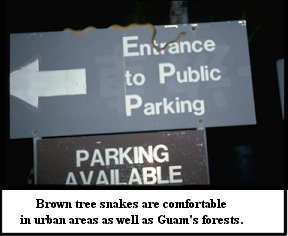
FORT > Resources > Education > BTS Home Page > BTS Impact > Economic Damages
Economic Damages from the Brown Tree Snake
Nearly every industry, governmental program, and indeed every person on Guam is affected in one way or another by the presence of the brown Treesnake.
Electrical Outages: Approximately every third day there is a snake-caused power outage somewhere on Guam. While most of these affect a limited area, some are widespread or island-wide blackouts. Everything from school lighting, computers used by retail outlets, traffic signals, to refrigeration of perishable goods are subject to these power interruptions. The costs due to direct damages and lost productivity are conservatively estimated at $1-4 million dollars each year.
 Lost Tourism Dollars:
Guam is a popular vacation destination, although the brown Treesnake's
reputation causes difficulty here too and may cause some prospective tourists
to shorten their visit or choose an alternate destination. Since
tourism is only outranked by U.S. military and government expenditures
in economic importance, lost tourism dollars could cause major economic
stress. For those that do choose to travel to Guam, snakes are commonly
found in urban areas and commercial buildings where they startle people,
especially those not used to living in close proximity to snakes.
The effects of electrical problems are also evident, as outages frequently
cut short tourists' enjoyment of Guam's nightlife and shopping centers.
Lost Tourism Dollars:
Guam is a popular vacation destination, although the brown Treesnake's
reputation causes difficulty here too and may cause some prospective tourists
to shorten their visit or choose an alternate destination. Since
tourism is only outranked by U.S. military and government expenditures
in economic importance, lost tourism dollars could cause major economic
stress. For those that do choose to travel to Guam, snakes are commonly
found in urban areas and commercial buildings where they startle people,
especially those not used to living in close proximity to snakes.
The effects of electrical problems are also evident, as outages frequently
cut short tourists' enjoyment of Guam's nightlife and shopping centers.
Slowed Transportation/Shipping: Guam is a major hub of air traffic. Cargo is sent from and shipped through Guam on a daily basis. With each outgoing flight, there is the chance that a snake may have been accidentally packed with the cargo, or crawled into the cargo space or even wheelwells of the aircraft. Canine detection is currently being used to inspect outgoing cargo and aircraft, and research is ongoing for an effective fumigant. However, both of these solutions cause delays in shipping time, influence preferred shipping routes, and slow commerce, which may cause added expense to consumers and discourage use of Guam as a trans-shipment center.
Cost to the Federal and Territorial Governments: Nearly every wildlife program in Guam's Division of Aquatic and Wildlife Resources is affected by and focused on problems caused by the brown tree snake. These programs are funded for several hundred thousand dollars from the U.S. Fish and Wildlife Service. Major staff commitments by U.S. Fish and Wildlife Service's Honolulu Office also focus on snake problems. Planning and remediation of endangered species issues add to the costs of major construction projects and many facets of military use of bases on Guam and other islands in the Marianas. Although costs for military and civilian installations to provide and maintain emergency electrical supplies have not been estimated, research and control of brown Treesnakes requires nearly $4 million per year in addition to costs for management of Guam's National Wildlife Refuge and military environmental programs. The governments of Hawaii and the Northern Marianas have staff and detection dog teams devoted to interdiction of snakes in cargo from Guam, while other islands and nongovernmental agencies maintain educational programs to heighten awareness and vigilance.
Increased Healthcare Costs: 1 out of every 1,000 visits to the emergency room on Guam is due to snakebite. Envenomated children are monitored closely for signs of respiratory distress, neurological dysfunction, and pronounced swelling in the vicinity of the bite. Besides the direct effects of brown Treesnake bites, there is also the danger of increased disease carried by insects that were previously kept in check by Guam's native lizards and birds. Examples of this include an outbreak of dengue fever carried by mosquitoes and a high rate of infant salmonellosis for several years.
Agricultural Damages: Since the brown Treesnake preys heavily on avian species, it is difficult to raise commercial poultry on Guam. As an example, most eggs for general consumption have to be imported. In addition, insect species that are no longer naturally controlled reduce yields of fruits and vegetables grown on Guam and require heavier dependence on pesticides. Problems caused by the brown tree snake have played a significant role in the fact that agriculture has continually declined in importance on Guam since 1945.
Report Snake Sightings!
Search FORT